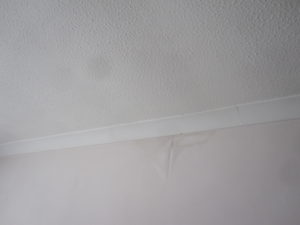There are basically four types of damp found in homes:
- Penetrating damp
- Rising damp
- Condensation
- Steaming up
We cover each briefly below, but condensation is the one we are mainly concerned about in carrying out draught proofing to existing homes.
1. Penetrating Damp

Penetrating Damp is caused by water seeping into the property from leaking pipes, guttering, overflows or holes in the roof, round windows etc. This type of damp leaves a ‘tide mark’ around the affected area. Tide marks can also result from old leaks but they don’t move or from leaking plumbing, most commonly leaks from showers.
2. Rising Damp
Rising damp is very rare and is happens to ground floors only, it is caused by moisture in the ground being sucked up by the walls of the property. This is due to a defective or missing damp-proof course in combination with impermeable wall surfaces. The damp will not rise more than a metre up the wall from ground level. Rising damp can cause flaking plaster, paint and render and salt deposits may be seen on internal walls and external brickwork.
Beware of damp meters prevalent in the industry, I always drill a hole and weigh the dust, dry it in an airing cupboard and reweigh to calculate the percentage moisture content. Nothing else is any good apart from a carbide test. See the video below for an example of how damp meters can mislead.
3. Condensation
Condensation is the most common type of damp. There is always moisture in the air and when warm damp air reaches cold surfaces (like windows) tiny drops of water can appear. Condensation mostly occurs during cold weather. In places where there is little movement of air, for example in the corners of rooms, behind wardrobes and near windows where it cannot re-evaporate very easily can lead to mould growth. It is also common to see mould growing on ceilings in bedrooms where there is a patch of insulation missing above. See below for some common examples of condensation by visiting our gallery.
4. Steaming up
When we boil things or take a bath or shower, the room steams up. This is not really condensation in the sense that we are talking about. It is unavoidable in shower or bathrooms. The key to not having problems is for it to go away on its own or with a little help before the next use. Squeegee down the tiles and screen, hang the shower curtain if you have one in the open position, open the window. Don’t just walk out if you are having problems with black mould.
